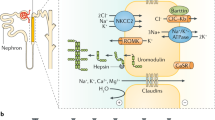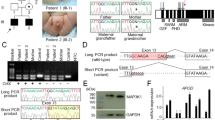Abstract
Frasier syndrome (FS) is a rare disease defined by male pseudo-hermaphroditism and progressive glomerulopathy1–3. Patients present with normal female external genitalia, streak gonads and XY karyotype4 and frequently develop gonadoblastoma1,2,5,6. Glomerular symptoms consist of childhood proteinuria and nephrotic syndrome, characterized by unspecific focal and segmental glomerular sclerosis, progressing to end-stage renal failure in adolescence or early adulthood4. No case of Wilms′ tumour has been reported, even in patients with extended follow-up1–5. In contrast with FS patients, most individuals with Denys-Drash syndrome (DOS; refs 6,7) have ambiguous genitalia or a female phenotype, an XY karyotype and dysgenetic gonads. Renal symptoms are characterized by diffuse mesangial sclerosis, usually before the age of one year, and patients frequently develop Wilms′ tumour8–9. Mutations of the Wilms′-tumour gene, WT1, cause different pathologies of the urogenital system, including DDS10–12. WT1 is composed of ten exons and encodes a protein with four zinc-finger motifs and transcriptional and tumoursuppressor activities13–15. Alternative splicing generates four isoforms: the fifth exon may or may not be present, and an alternative splice site in intron 9 allows the addition of three amino acids (KTS) between the third and fourth zinc fingers of WT1 (ref. 17). Here we demonstrate that FS is caused by mutations in the donor splice site in intron 9 of WT1, with the predicted loss of the +KTS isoform. Examination of WT1 transcripts indeed showed a diminution of the +KTS/-KTS isoform ratio in patients with FS.
This is a preview of subscription content, access via your institution
Access options
Subscribe to this journal
Receive 12 print issues and online access
$209.00 per year
only $17.42 per issue
Buy this article
- Purchase on Springer Link
- Instant access to full article PDF
Prices may be subject to local taxes which are calculated during checkout
Similar content being viewed by others
References
Frasier, S., Bashore, R.A. & Mosier, H.D. Gonadoblastoma associated with pure gonadal dysgenesis in monozygotic twins. J. Pediatr. 64, 740–745 (1964).
Haning, R.V., Chesney, R.W., Moorthy, A.V. & Gilbert, E.F. A syndrome of chronic renal failure and XY gonadal dysgenesis in young phenotypic females without genital ambiguity. Am. J. Kidney Dis. 6, 40–48 (1985).
Kinberg, J.A., Angle, C.R. & Wilson, R.B. Nephropathy-gonadal dysgenesis, type 2: renal failure in three siblings with dysgenesis in one. Am. J. Kidney Dis. 9, 507–510 (1987).
Moorthy, A.V., Chesney, R.W. & Lubinsky, M. Chronic renal failure and XY gonadal dysgenesis: “Frasier” syndrome— commentary on reported cases. Am. J. Med. Genet. 3, 297–302 (1987).
Blanchet, P., Daloze, P., Lesage, R., Papas, S. & van Campenhout, J. XY gonadal dysgenesis with gonadoblastoma discovered after kidney transplantation. Am. J. Obstet Gynecol. 129, 221–222 (1977).
Drash, A., Sherman, F., Hartmann, W.H. & Blizzard, R.M. A syndrome of pseudohermaphroditism, Wilms' tumor, hypertension and degenerative renal disease. j Pediatr. 76, 585–593 (1990).
Denys, P., Malvaux, P., van den Berghe, H., Tanghe, W. & Proesmans, W. Association d'un syndrome anatomo-pathologique de pseudo-hermaphrodisme masculin, d'une tumeur de Wilms, d'une néphropathie parenchymateuse et d'un mosaicisme XX/XY. Arch. Fr. Pediatr. 24, 729–739 (1967).
Jadresic, L. et al. Clinicopathologic review of twelve children with nephropathy, Wilms' tumor and genital abnormalities (Drash syndrome). J. Pediatr. 117, 717–725 (1990).
Habib, R. et al. The nephropathy associated with male pseudo-hermaphroditism and Wilms' tumor (Drash syndrome): a distinctive glomerular lesion, report of 10 cases. Clin. Nephrol. 24, 269–278 (1985).
Pelletier, J. et al. Germline mutations in the Wilms' tumor suppressor gene are associated with abnormal urogenital development in Denys-Drash syndrome. Cell. 67, 437–447 (1991).
Hastie, N.D. Dominant negative mutations in the Wilms' tumour (WT1) gene cause Denys-Drash syndrome-proof that a tumour-suppressor gene plays a crucial role in normal genitourinary development. Hum. Mol. Genet. 1, 293–295 (1993).
Little, M. & C A clinical overview of WT1 gene mutations. Hum. Mutat. 9, 209–225 (1997).
Call, K.M. et al. Isolation and characterization of a zinc finger polypeptide gene at the human chromosome 11 Wilms' tumor locus. Cell. 60, 509–520 (1990).
Gessler, M. et al. Homozygous deletion in Wilms' tumor of a zinc-finger gene identified by chromosome jumping. Nature. 343, 774–778 (1990).
Pritchard-Jones, K. et al. The candidate Wilms' tumour gene is involved in genitourinary development. Nature. 346, 194–197 (1990).
Kennedy, D., Ramsdale, T., Mattick, J. & Little, M. An RNA recognition motif in Wilms' tumour protein (WT1) revealed by structural modelling. Nature Genet. 12, 329–332 (1996).
Haber, D.A. et al. Alternative splicing and genomic structure of the Wilms' tumor gene WT1. Proc. Natl. Acad. Sd. USA. 88, 9618–9622 (1991).
Kreidberg, J.A. et al. WT-1 is required for early kidney development. Cell. 74, 679–691 (1993).
Coppes, M.J., Huff, V. & J Denys-Drash syndrome: relating a clinical disorder to genetic alterations in the tumor suppressor gene WT1. J. Pediatr. 123, 673–678 (1993).
Berta, P. et al. Molecular analysis of the sex-determining region from the Y chromosome in two patients with Frasier syndrome. Horm. Res. 37, 103–106 (1992).
Poulat, F. et al. Distinct molecular origins for Denys-Drash and Frasier syndromes. Hum. Genet. 91, 285–286 (1993).
Brunak, S. & Engelbrecht, J. Prediction of human mRNA donor and acceptor sites from the DMA sequence. J. Mol. Biol. 220, 49–65 (1991).
Bruening, W. et al. Germline intronic and exonic mutations in the Wilms' tumour gene (WT1) affecting urogenital development. Nature Genet. 1, 144–148 (1992).
Konig, A., Jakubiczka, S., Wieacker, P., Schlosser, H.W. & M Further evidence that imbalance of WT1 isoforms may be involved in Denys-Drash syndrome. Hum. Mol. Genet. 2, 1967–1968 (1993).
Bardeesy, N., Zabel, B., Schmitt, K. & J WT1 mutations associated with incomplete Denys-Drash syndrome define a domain predicted to behave in a dominant-negative fashion. Genomics. 21, 663–665 (1994).
Bruening, W. & J Denys-Drash syndrome: a role for the WT1 tumour suppressor gene in urogenital development. Semin. Dev. Biol. 5, 333–343 (1994).
Schmitt, K., Zabel, B., Tulzer, G., Eitelberger, F. & Pelletier, J. Nephropathy with Wilms' tumour or gonadal dysgenesis: incomplete Denys-Drash syndrome or separate diseases? Eur. J. Pediatr. 154, 577–581 (1995).
Hewitt, S.M., Fraizer, G.C., Wu, Y.J., Rauscher, F.J. & Saunders, G.F. Differential function of Wilms' tumor gene WT1 splice isoforms in transcriptional regulation. J. Biol. Chem. 271, 8588–8592 (1996).
Wang, Z.Y., Qiu, Q.Q., Huang, J., Gurrieri, M. & Deuel, T.F. Products of alternatively spliced transcripts of the Wilms' tumor suppressor gene, WT1, have altered DNA binding specificity and regulate transcription in different ways. Oncogene. 10, 415–422 (1995).
Bickmore, W.A. et al. Alternative splicing within the zinc finger region of the Wilms' tumour WT1 gene modulates DNA binding specificity. Science. 257, 235–237 (1992).
Larsson, S.H. et al. Subnuclear localization of WT1 in splicing or transcription factor domains is regulated by alternative splicing. cell. 81, 391–401 (1995).
Kent, J., Coriat, A.M., Sharpe, P.T., Hastie, N.D. & van Heyningen, V The evolution of WT1 sequence and expression pattern in vertebrates. Oncogene. 11, 1781–1792 (1995).
Author information
Authors and Affiliations
Rights and permissions
About this article
Cite this article
Barbaux, S., Niaudet, P., Gubler, MC. et al. Donor splice-site mutations in WT1 are responsible for Frasier syndrome. Nat Genet 17, 467–470 (1997). https://doi.org/10.1038/ng1297-467
Received:
Accepted:
Issue Date:
DOI: https://doi.org/10.1038/ng1297-467
This article is cited by
-
Hallmark discoveries in the biology of Wilms tumour
Nature Reviews Urology (2024)
-
Benchmarking splice variant prediction algorithms using massively parallel splicing assays
Genome Biology (2023)
-
Amenorrhea in a pediatric kidney transplant recipient: Answers
Pediatric Nephrology (2022)
-
WT1 complete gonadal dysgenesis with membranoproliferative glomerulonephritis: case series and literature review
Pediatric Nephrology (2022)
-
A case of Potter sequence with WT1 mutation
CEN Case Reports (2022)



